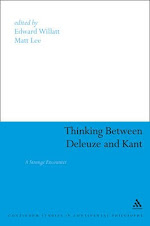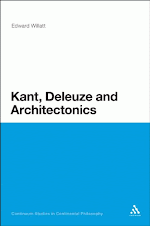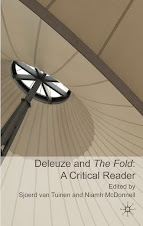Text for 19th February Workshop on 'The Essays of Gilles Deleuze'
The Actual and the Virtual [1] (from Gilles Deleuze & Claire Parnet, Dialogues II, Continuum, London, 2002, pp. 112-5. N.B this piece does not appear in the first edition of Dialogues)
Nick has provided the following highly useful corrections to translations of some passages:
Part 1 End of 4th sentence of para 1: italicise "run"
6th sentence para 1: italicise "brevity"
Last sentence of para 1: "These are memories of different orders, they are called virtual images because their speed or brevity here keeps them under a principle of unconsciousness." ["orders" not "sorts"]
2nd sentence para 2: italicise "a spatium"
3rd sentence para 2: "The more or less deep layers of the actual object correspond to these,,," [italics and "deep" not "dense"]
Towards end of para 2: "But all the planes merge into one folllowing the path which leads to the virtual" ["virtual" not "actual"!]
Part 2
3rd sentence para 1: "You get to an inner circuit which links only to the actual object and its virtual object..." [italicise "its"]
Last sentence para 1: "There is no longer unassignability of the actual and the virtual, but indiscernibility between the two terms which interchange." [N.B. this sentence is almost repeated in the last sentence of next para.]
5th sentence etc. para 2 "But on its side the virtual appears in a time that is smaller than that which measures the minimum of movement in a single direction. That is why the virtual is "ephemeral". But it is also in the virtual that the past is conserved, since this ephemera does not cease to continue in the following "smallest time", which refers to a change of direction. The time smaller than the minimum of thinkable continuous time in one direction is also the longest time, longer than the maximum of continuous time thinkable in all directions." [the translation phrase "making minute adjustments in response to changes of direction" bears very little relation to the French]
1st sentence para 3: "...sometimes the actual refers to the virtual as its own virtual..." [italicise "its own" ]
Last sentence para 3: "Actuals imply already constituted individuals, and determinations by ordinary points, whereas the relation of the actual to the virtual forms an ongoing individuation or a singularisation by remarkable points to be determined in each case." [translation misses out the reference of singular and ordinary to points which is important]
______________
Translated by Eliot Ross Albert [2]
I
Philosophy is the theory of multiplicities, each of which is composed of actual and virtual elements. Purely actual objects do not exist. Every actual surrounds itself with a cloud of virtual images. This cloud is composed of a series of more or less extensive coexisting circuits, along which the virtual images are distributed, and around which they run. [3] These virtuals vary in kind as well as in their degree of proximity from the actual particles by which they are both emitted and absorbed. They are called virtual in so tar as their emission and absorption, creation and destruction, occur in a period of time shorter than the shortest continuous period imaginable; it is this very brevity, that keeps them subject to a principle of uncertainty or indetermination. The virtuals, encircling the actual, perpetually renew themselves by emitting yet others, with which they are in turn surrounded and which go on in turn to react upon the actual; 'in the heart of the cloud of the virtual there is a virtual of a yet higher order . . . every virtual particle surrounds itself with a virtual cosmos and each in its turn does likewise indefinitely.' [4] It is the dramatic identity of their dynamics that makes a perception resemble a particle: an actual perception surrounds itself with a cloud of virtual images, distributed on increasingly remote, increasingly large, moving circuits, which both make and unmake each other. These are memories of different sorts, but they are still called virtual images in that their speed or brevity subjects them too to a principle of the unconsciousness.
It is by virtue of their mutual inextricability that virtual images are able to react upon actual objects. From this perspective, the virtual continuum, whether one takes all of the circles together or each individually, is a spatium determined in each case by the maximum of time imaginable. The varyingly dense layers of the actual object correspond to these, more or less extensive, circles of virtual images. These layers, whilst themselves virtual, and upon which the actual object becomes itself virtual, constitute the total impetus of the object. [5] The plane of immanence, upon which the dissolution of the actual object occurs, is itself constituted when both obect and image are virtual. But the process of actualization undergone by the actual is one which has as great an effect on the image as it does on the obect. The continuum of virtual images is fragmented and the spatium cut up according to whether the temporal decompositions are regular or irregular. The total impetus of the virtual object splits into forces corresponding to the partial continuum, and the speeds traversing the cut-up spatium. [6] The virtual is never independent of the singularities which cut it up and divide it out on the plane of immanence. As Leibniz has shown, force is as much a virtual in the process of being actualized as the space through which it travels. The plane is therefore divided into a multiplicity of planes according to the cuts in the continuum, and to the divisions of force which mark the actualization of the virtual. But all the planes merge into one following the path which leads to the actual. The plane of immanence includes both the virtual and its actualization simultaneously, without there being any assignable limit between the two. The actual is the complement or the product, the object of actualization, which has nothing but the virtual as its subect. Actualization belongs to the virtual. The actualization of the virtual is singularity whereas the actual itself is individuality constituted. The actual falls from the plane like a fruit, whilst the actualization relates it back to the plane as if to that which turns the object back into a subject.
II
Thus far we have considered those cases in which the actual is surrounded by increasingly extensive, remote and diverse virtualities: a particle creates ephemera, a perception evokes memories. But the inverse movement also occurs: in which, as the circles contract, the virtual draws closer to the actual, both become less and less distinct. You get to an inner circuit which links only the actual object and its virtual image: an actual particle has its virtual double, which barely diverges from it at all; an actual perception has its own memory as a sort of immediate, consecutive or even simultaneous double. [7] For, as Bergson shows, memory is not an actual image which forms after the object has been perceived, but a virtual image coexisting with the actual perception of the object. Memory is a virtual image contemporary with the actual object, its double, its 'mirror image' [8] as in The Lady from Shanghai, in which the mirror takes control of a character, engulfs him and leaves him as just a virtuality; hence, there is coalescence and division, or rather oscillation, a perpetual exchange between the actual object and its virtual image: the virtual image never stops becoming actual. The virtual image absorbs all of a character's actuality, at the same time as the actual character is no more than a virtuality. This perpetual exchange between the virtual and the actual is what defines a crystal; and it is on the plane of immanence that crystals appear. The actual and the virtual coexist, and enter into a tight circuit which we are continually retracing from one to the other. This is no longer a singularization, but an individuation as process, the actual and its virtual: no longer an actualization but a crystallization. Pure virtuality no longer has to actualize itself, since it is a strict correlative of the actual with which it forms the tightest circuit. It is not so much that one cannot assign the terms 'actual' and 'virtual' to distinct objects, but rather that the two are indistinguishable.
The actual object and the virtual image, the object become virtual, the image actual, are all figures dealt with in elementary optics.[9] This distinction between the virtual and the actual corresponds to the most fundamental split in time, that is to say, the differentiation of its passage into two great jets: the passing of the present, and the preservation of the past. The present is a variable given measured in continuous time, a supposedly mono-directional movement, in which the present passes up until the exhaustion of that time.10 The actual is defined by this passing of the present. But the virtual's ephemerality appears in a smaller space of time than that which marks the minimum movement in a single direction. This is why the virtual is 'ephemeral', but the virtual also preserves the past, since that ephemeraslity is continually making minute adjustments in response to changes of direction. The period of time which is smaller than the smallest period of continuous time imaginable in one direction is also the longest time, longer than the longest unit of continuous time imaginable in all directions. The passing of the present, the preservation and self-preservation of the ephemeral each occur according to their own scale of measurement. Virtuals communicate directly over the top of the actuals which separate them. The two aspects of time, the actual image of the present which passes and the virtual image of the past which is preserved, are distinguishable during actualization although they have unassignable limits, but exchange during crystallization to the extent that they become indiscernible, each relating to the role of the other. The relationship between the actual and the virtual takes the form of a circuit, but it does so in two ways: sometimes the actual refers to the virtuals as to other things in the vast circuits where the virtual is actualized; sometimes the actual refers to the virtual as its own virtual, in the smallest circuits where the virtual crystallizes with the actual. The plane of immanence contains both actualization as the relationship of the virtual with other terms, and even the actual as a term with which the virtual is exchanged. In any case, the relationship between the actual and the virtual is not the same as that established between two actuals. Actuals imply already constituted individuals, and are ordinarily determined, whereas the relationship of the actual and the virtual forms an acting individuation or a highly specific and remarkable singularization which needs to be determined case by case.
Notes
1* Translator's note: The reader familiar with Deleuze's work cannot help but be struck by something odd, something disquieting, in the French 'L'actuel et la virtuel'. The anomalous nature of the piece is most evident on the stylistic plane, for unlike most of Deleuze's writing, in which a thought of soaring complexity is expressed with an elegant, limpid clarity, 'L'actuel' is composed of a series of jarringly repetitive monophrasal sentences. Sentences which are frequently blunt assertions of the form 'the virtual is x' rather than Deleuze's customary rigorous philosophical argumentation. My personal suspicion, and the only way to satisfactorily account for the oddity of the text, is that, rather than a finished paper, 'L'actuel et la virtuel' is a series of drafts, or aides-memoires for a paper. Neither the French edition nor the Italian translation (the two editions that I have seen of the text) voices any concerns; however, when 1 raised my reservations about the text with Eric Alliez, one of the most perceptive of Deleuze's readers, he replied '. 'quite obvious' that 'L'actuel et la virtuel' is a draft.
2* Translator's note: Both Caroline Warman and Matteo Mandanr made insightful comments on early versions of this translation, comments which no doubt improved it immeasurably and for which I thank them.
3* Translator's note: Cf. Gilles Deleuze, Difference et repetition (Vendom: Universitaires de France, 1968), trans. by Paul Patton as Difference and Repetition (London: Athlone Press, 1994), pp. 270-1/209: 'Every object is double without it being the case that the two halves resemble one another, one being a virtual image and the other an actual image.'
4 Michel Casse, Du vide et de la creation (Paris: Editions Odile Jacob), pp. 72-3. See also Pierre Levy's study, Qu'est ce que la virtuel? (Paris: Edit:. Decouverte).
5 Henri Bergson, Matiere et la memoire (Paris: Editions du centenaire), trans. by N. M.Paul and W. S. Palmer as Matter and Memory (New York: Zone Books,1991), p. 250/104; chapters II and III analyse the virtuality of memory and its actualization. [Translator's note: It is worth noting that these chapters also contain the elaboration of the interlinked concepts of the circuits of memory, contraction and expansion, the coexistence of past with the present, that provide the basis for Bergson's utterly non-psychologizing account of memory, as well as the opening, and indeed ever-present, structure of the present article. The concept of the circuit is introduced by Bergson as an explicit challenge to, and attack upon, the then-dominant accounts of memory in the following way: 'There is supposed to be a rectilinear progress, by which the mind goes further and further from the object, never to return to it. We maintain, on the contrary, that reflective perception is a circuit, in which all the elements, including the perceived object itself, hold each other in a state of mutual tension' (p. 250/104).]
6 See Gilles Chatelet, Les Enjeux du mobile (Paris: Editions du Seuil), pp. 54-68 (from 'virtual speeds' to 'virtual cuts').
7* Translator's note: This 'inner circuit' is what Bergson describes as the 'moment when the recollection ... is capable of blending so well with the present perception that we cannot say where memory begins' (Matter and Memory, p. 106).
8 Henri Bergson, L' Entree spirituelle, 'memory ot the present', pp. 917-20. Bergson insists on two movements, that towards larger and larger circles and that towards a narrower and narrower circle. [Translator's note: Mind-Energy, trans. by H. Wildon Carr (London: Macmillan, 1920), pp. 134-7. Bergson writes: 'Memory seems to be to the perception what the image reflected in the mirror is to the object in front of it. The object can be touched as well as seen; it acts on us as well as we on it; is pregnant with possible actions; it is actual' (p. 134).]
9 The discipline of optics takes the actual object and the virtual image as its starting-points and shows in what circumstances that object becomes virtual, that image actual, and then how both object and image become either actual or virtual.
10* Translator's note: Deleuze had referred to this split, inherited from Bergson earlier in his work, perhaps most notably in his exposition of crystal time in Cinema 2: The Time-Image, trans. by Hugh Tomlinson and Robert Galeta (London: The Athlone Press, 1989), were he writes of time splitting into ''two dissymmetrical jets, one of which makes all the present pass on, while the other preserves all the past' (p. 81) '. One can go further and suggest that, as Deleuze notes above, much ol the conceptual basis for the present piece is derived from the section on the 'memory of the present' in Bergson's .L'Energie spirituelle, and that a great deal of it had already been extensively developed and deployed in the above-mentioned chapter of Cinema 2. it is worth remembering as a subject for further investigation that Walter Benjamin - whose admiration for Bergson is well known but, as yst, inadequately explored - had, in an important passage in the Arcades Project (Cambridge, MA: Harvard University Press, 1999), referred to 'the crystal of the total event' (N2, 6)




